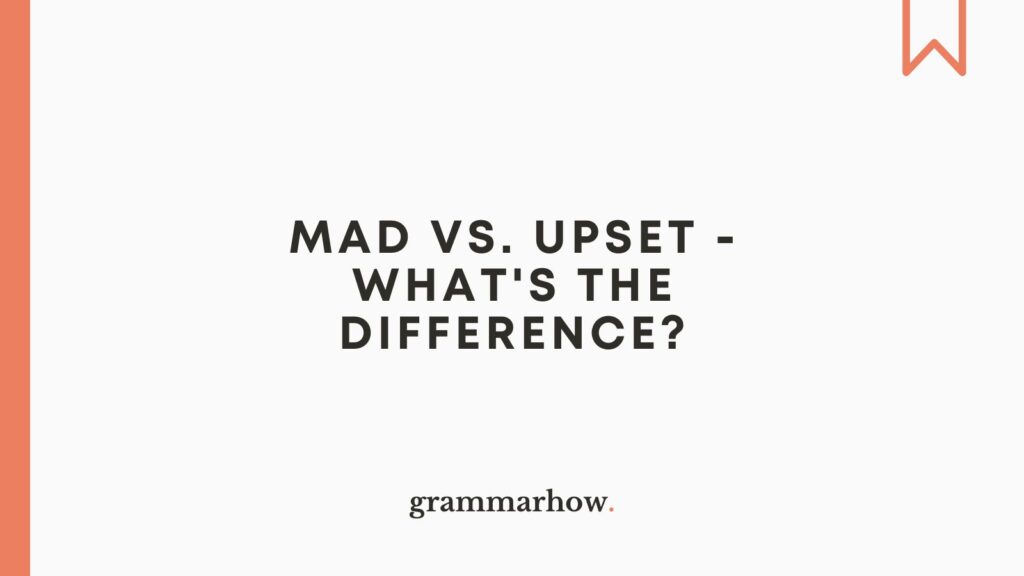Have you found yourself wondering about the differences between “mad” and “upset”? Actually, they’re not all that similar.
It would help to know which to use in different situations. So, this article will explain all there is to know about them.
Mad vs. Upset – What’s the Difference?
“Mad” is a negative emotion relating to anger and hostility. You could say, “I’m so mad that you did that” because someone messed up. “Upset” is a negative emotion relating to sadness or disappointment. For example, “I’m so upset about this” shows you are sad about something happening.
Don’t worry; there are a few more examples that will help you figure it out:
- I’m so mad at you. I can’t believe you thought I wouldn’t find out what you were doing!
- I’m too upset to think straight. I’ve never been so ashamed of my family.
Keep reading to learn more about the differences between being mad and upset. We’ve covered everything you need to know, as well as how to use them in a sentence.
Mad
Let’s start with “mad.” It means that someone is angry or frustrated about something. Generally, someone who is mad is more prone to arguing or hostilities because they cannot control their negative emotions.
Here’s a quick look at how you can use it in a sentence:
- You must be mad for thinking that I would do that to you again! I can’t believe it.
- She’s so mad at me. I think I really messed everything up this time. She’ll never forgive me.
The definition of “mad,” according to The Merriam-Webster Dictionary, is “intensely angry or displeased.”
You can use “mad” as an extreme emotion, showing that you are overwhelmed with anger or displeasure. It’s a great term to amplify your emotions and show someone just how badly they annoyed you.
Upset
“Upset” is a more gentle emotion, though it’s still a negative one. It simply means that you are sad or disappointed about an outcome.
Here’s how you can use “upset” in a sentence:
- You don’t have to be upset anymore. I’ve corrected most of the things I did wrong the first time around.
- I’m too upset with them both. I didn’t think they would do something so mean.
The Merriam-Webster Dictionary defines “upset” as “emotionally disturbed or agitated.”
As you can see, “upset” is generally less about anger and more about sadness. It shows that you are uncomfortable or disturbed due to sad feelings rather than angry ones.
Angry
It’s worth explaining a bit more about “angry” as an adjective too. “Mad” is fairly close to “angry,” but they are not the same terms.
“Angry” means frustrated or annoyed. It is less extreme than feeling “mad.”
Here’s how to use “angry” in a sentence:
- I’m very angry. I’ll have to have a conversation with him when he gets back.
- You need to calm down. Being this angry won’t get you anywhere!
The definition of “angry,” according to The Merriam-Webster Dictionary, is “feeling or showing anger.”
You could say that “mad” means “extreme anger.” Therefore, “mad” is the next level above “angry,” so you should reserve it more for situations that really annoy you.
Conclusion
“Mad” shows that you are extremely angry about something. It is an intense emotion that you often can’t control.
“Upset” is much tamer. It simply means sad or disappointed, especially when something bad happens.
“Angry” is somewhere between the two. You should use it when frustrated or displeased with a situation. Though it does not work when overwhelmed with anger and aggression.

Martin holds a Master’s degree in Finance and International Business. He has six years of experience in professional communication with clients, executives, and colleagues. Furthermore, he has teaching experience from Aarhus University. Martin has been featured as an expert in communication and teaching on Forbes and Shopify. Read more about Martin here.

